| Sep-18-09 | | WhiteRook48: namesake openings? |
|
Sep-01-20
 | | KEG: Hoffer in the Tournament Book called this "an uneventful draw." But there was a bit more to this game than that. Going into the last round game, Alapin seemed nearly certain to end up in 5th place. None of the players below him had any chance to catch him, and even if Alapin had won both this game and his pending replay with Mason, he had no chance to catch Janowski for first, could at best have caught Tchigorin, and had only a small chance to overtake Schlechter or von Scheve. Meanwhile, Blackburne needed a guarantee sole possession of 6th prize, and--given that Mieses won his 13th round game--needed to win at least the replay even to tie for 6th prize (the last prize awarded). Blackburne's task was not easy. Alapin lost only one game at Monte Carlo 1901 (though he drew too many games for a really high finish). Alapin played his patented variation against Blackburn's Sicilian, and had several chances early to win. After that, neither side was able to obtain a major advantage until Blackburn's blunder on move 33 (which Alapin failed to exploit). Though the game thereafter petered out to a draw, the real excitement lay in the variations that were NOT played. 1. e4 c5
2. c3
Alapin's Variation.
2... Nc6
2...Nf6 is most normal and arguably best. But the text is certainly OK, and has been played at least twice by Magnus Carlsen. 3. d4 cxd4
3...d5 may be even better. Both lead to approximate equality. 4. cxd4 d5

click for larger view5. Nc3
5. exd5 is simplest and probably best. The text, which was played by Liem back in 2013 in a Rapid tournament, should probably yield no more than equality. 5... Nf6
5...e6 is also possible.
6. e5
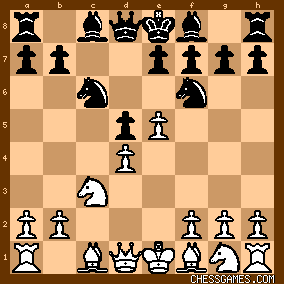
click for larger view6... Ng8?!
Zooks! Oh well, this is Blackburne!
6...Ne4 is obviously best. Blackburne, however, made a living finding ways to counterattack from seemingly cramped and horrible-looking positions. 7. Nf3 e6
Here, 7...Bg4 looks strongest. Blackburne, as often was the case,chose to dig a hole for himself in the opening. 8. Bd3 a6
Still looking for unclear lines. 8...Nge7 looks most sensible. 9. 0-0
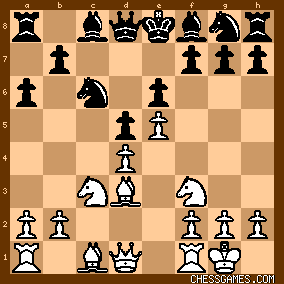
click for larger view9... f5?!
Still playing for...well, beats me. I initially thought Blackburne was trying to set up some sort of Stonewall. But the subsequent course of the game refuted this speculation. Most players would just settle for 9...Nge7 here. 10. Be3 g6
Now I was sure Blackburne was aiming for a Stonewall. (Silly me!). He could have played 10...Nge7 or 10...Bd7 or 10...Nh6. But as we will see, Blackburn had other ideas. 11. Rc1 Bh6
Ah, he wants to trade Bishops.
12. Qd2 BxB
13. QxB
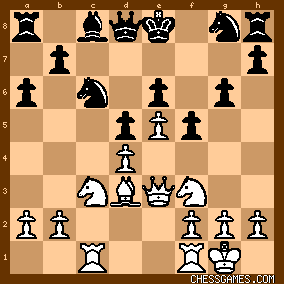
click for larger view |
|
Sep-02-20
 | | KEG: Post II
13... h5?
Even if this were (as I mistakenly thought when I played over the game the first time) part of a Stonewall strategy, it would be a serious mistake since it leaves too many weak dark squares in Blackburne's King-side. In fact, and as soon becomes clear, the text was not only intrinsically bad, but was also part of a bad plan by Blackburne to create a King-side attack of his own out of thin air. As is obvious, Black is not ready to initiate any such attack. Best for Black here was 13...h6. Alternatively, he might have tried 13...Kf7 or 13...Nb4. After the text, Black's vulnerability was obvious: 
click for larger view14. Ne2
Even better were 14. h4 (ending Black's notion of playing h4 himself) or 14. Na4 (beginning Queen-side operations). 14... Nh6
I not saying it's right, but 14...h4 immediately would have been consistent with Blackburne's plan. 15. Ng5?
Missing his chance to play 15. h4. 15. Bc2 and 15. g3 were other good options. The misguided text gave Blackburne time to pursue his plan and to thwart whatever Alapin had in mind with the text. 15... h4
Better still, Blackburne could just have played 15...Nf7 immediately. The position was now:

click for larger view16. h3 Nf7
17. NxN
Pretty much conceding the error of his 15th move. He could have played 17. Nf3, but it is difficult for any red-blooded chess player to make such a concession. 17... KxN

click for larger view18. f4?!
Needlessly compromising his own game. Among other things, the text blocked his own Knight from going to f4. Best for White here was simply to regroup with 18. Nc3, retaining some real advantage. 18... Bd7
19. a3
Not bad in itself, but the beginning of another bad plan by Alapin (i.e., a Queen-side pawn advance). 19... Rc8
This Rook move worked better for Blackburne than it should have. 20. b4
Continuing with his idea from his last move.
20... Na7
21. RxR?
Typical of Alapin's unduly cautious play at Monte Carlo 1901. This exchange left White safe, but forfeited most of his (dwindling) remaining advantage. 21... NxR

click for larger view22. Nc1
Taking caution beyond all reasonable bounds. 22. Rc1 was indicated. After the text, Alapin no longer enjoyed any advantage. 22... Ba4
23. Na2
Taking the Knight on a potentially long journey. 23... Bb3
24. Nc3 Nb6
25. Rb1 Bc4
26. a4 BxB
27. QxB Nc4

click for larger viewChances were now about equal, and a draw seemed a likely result. But Blackburne needed a win, so the game now became exciting. |
|
Sep-03-20
 | | KEG: Post III
Theoretically, the position is about dead even. Just ask any computer. But that does not mean there isn't plenty of play for both sides. I would bet that Fischer or Carlsen would play hard for a win from either side of the board. And indeed both Alapin and Blackburne beginning here played some very strong and creative chess, at least for a while. 28. a5!
Preparing a Queen-side breakthrough.
28... g5!
Attacking on the opposite wing.
29. b5!
Continuing to press hard on the Queen-side:

click for larger view29... Rg8
Continuing his double-edged play. An exciting alternative was to accept the pawn sacrifice with 29...Qxa5. This could lead to wild play culminating with a Rook sacrifice by White to force a draw by perpetual check. To give just one of many fascinating variations: 30. bxa6 bxa6 31. Rb7+ Kg6 (forced) 32. Re7 gxf4 (once again, Black has little choice) 33. Rxe6+ Kg5 (forced) 34. Rf6 Ne3 (forced) 35. Rxa6 Qb4 (best) 36. Ra7 Qb2 37. Rg7+ Kh6 (forced) which would leave: 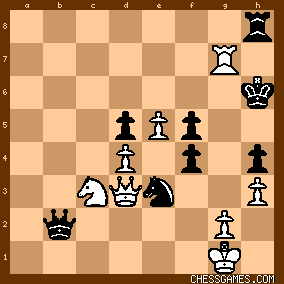
click for larger viewIs White in trouble here? Nope, he draws via 38. Qa6+ (the only move) KxR 39. Qf6+ Kb7 40. Qxh4+ Kg6 41. Qf6+ and draws by perpetual check. Getting back to the actual game, after Blackburne's 29...Rg8 (one move before the move-30 time control) the position was: 
click for larger view30. bxa6 bxa6
31. Rb7+
Alapin could also have played 31. Na4 which would likely have led to a position in which Blackburne would need to seek salvation in his own draw by perpetual check: 31. Na4 Qxa5 32. Nc5 (otherwise Black gets the edge) Nd2 33. Rb7+ Kg6 (forced) 34. Nxe6 after which Blackburne would have had to resort to perpetual check via: 34...Qa1+ 35. Kh2 Nf1+ 36. Kg1 Nd2+ 37. Kh2 etc. Returning to the actual game, after 31. Rb7+ the position was: 
click for larger view31... Kg6 (forced)
32. Ne2 Kh6
This gave Alapin some chances (which he did not seize). A fascinating line that would likely have led to a draw after a Queen sacrifice by White was: 32...Qxa5 33. Re7 Qe1+ 34. Kh2 Nd2 (forced) 35. Rxe6+ Kg7 (forced) 36. Re7+ (forced) Kh6 37. Re6+ Rg6 38. fxg5+ (forced) Kh7 39. Re7+ (forced) Kg8 40. Re8+ Kg7 41. Nf4 Nf1+ leaving: 
click for larger viewHere White must give up his Queen and seek a draw with 42. QxN QxQ 43. Re7+ Kg8 44. NxR Qf2 45. Rb7 Qg3+ 46. Kh1 Qf2 47. Kh2 and White draws with Rook and Knight against Queen in a remarkable position. Back to the actual game. After 32...Kh6 the position was: 
click for larger view |
|
Sep-04-20
 | | KEG: Post IV
33. Qc3
True to form, Alapin selected the safest move. More aggressive and potentially exciting were 33. fxg5+ and 33. Qb1, though those moves,like the text, lost likely lead to a draw with best play by both sides: (A) 33. fxg5+ can lead to an ending in which, though material is even, White has a dangerous passed pawn. Black has to keep alert to hold the game: e.g., 33. fxg5+ Qxg5 34. Qf3 (anything else would lead to danger for White) Nd2 35. Qf4 (the best chance) QxQ (forced) 36. NxQ Nf3+ (forced) 37. Kf2 Nxd4 38. Rb4 (the only winning chance) Nc6 (forced) 39. Rb6 Nxa5 40. Rxa6 (he could also play 40. Nxd5) Nc4 (forced) 41. Rxe6+ Kg5 (forced) 42. Nxd5 Rd8 43. Nb6 (nothing else is any better) NxN 44. RxN Rd2+ 45. Kf3 Rd3+ and Black should be able to hold on. (B) 33. Qb1 (another wild variation that should lead to a draw with best play on both sides:e.g., 33. Qb1 g4! (forced) 34. hxg4 (forced) Rxg4 35. Qb4 Qg8 36. Rb8 Rxg2+ 37. Kh1 Qg7 (obviously forced) 38. Rb7 (forced) Qg8 (forced) 39. Rb8 Qg7 40. Rb7 and draws by continuing to attack the Queen. After Alapin's actual 33. Qc3, the position was: 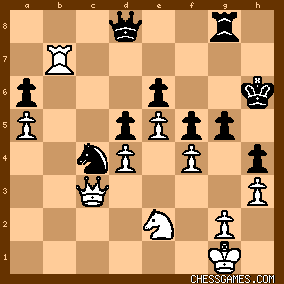
click for larger viewHere, Blackburne, desperate for a win, blundered and grabbed the a-pawn: 33... Qxa5?
Blackburne could have drawn via a line leading to play similar to the 33. Qb1 variation above: 33...g4! 34. hxg4 Rxg4 35. Qb4 (best) Qg8 36. Rb8 Rxg2+ 37. Kh1 Qg7 38. Rb7. But after the text (33...Qxa5?), the position was: 
click for larger viewAlapin could now have won with 34. fxg5+ Kxg5 (best) 35. Rb4 Qa2 (the best chance) 36. Qc1+ Kg6 37. Nf4+ Kh7 38. Rb7+ Kh6 39. Nxe6+ (39. Re7 probably also wins) Qd2 (forced) 40. QxQ+ NxQ 41. Ra7 and White wins the Black a-pawn and should win with his protected passed e-pawn. But instead, Alapin headed for a draw with the wimpy: 34. QxQ? NxQ
35. Rb6
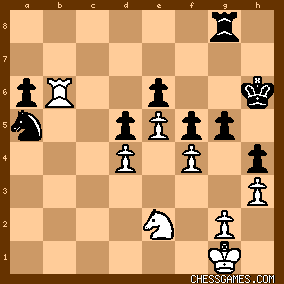
click for larger viewThough the Black a-pawn must fall, Blackburne had a fairly easy draw with 35...Re8. But, since a draw didn't suit Blackburne's purposes, he once again played for complications: 35... Rg6
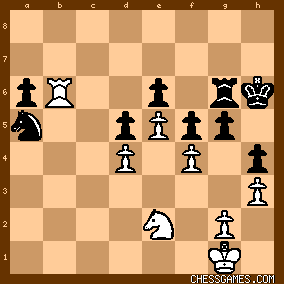
click for larger view36. Rxa6
Black can hold after 36. fxg5+, but it's tricky and exciting: e.g., 36. fxg5+ Kxg5 37. Rxa6 Nc4 38. Kf2 Rh6 39. Ra8 Rg6 40. Ra7 Rg8 41. Re7 Re8 42. Rxe6 Nd2 43. Rc6 Ne4+ 44. Ke1 f4! 45. Nc3 NxN 46. RxN Rb2 and Black, though down a pawn and confronted with a protected passed White e-pawn, has sufficient pressure and with the White King confined to its back rank should be able to draw without too much difficulty. After Alapin's actual 36. Rxa6, the situation was also exciting: 
click for larger viewWith his Rook and King bottled up, Blackburne now had to work hard to save th game. |
|
Sep-04-20
 | | KEG: Post V
36... Nc4
Best.
37. Kf2
Black would be OK after 37. fxg5+ Kxg5 38. Kf2 Rh6 39. Ra7 (or 37. Ra8) Rg6. After 37. Kf2, the position was:

click for larger view37... Nd2
Still looking to complicate. Theoretically best was the devilishly difficult to calculate 37...g4 38. hxg4 fxg4 (forced) 39. f5 g3+ (he could also play 33...exf5 here) 40. Kf3 exf5 41. e6 Kg5 (focred) 42. Nc3 Nd2+ 43. Ke3 (forced) Ne4 which would leave: 
click for larger viewNow the game could end in a draw following a spectacular line: 44. e7 RxR (forced) 45. e8(Q) NxN 46. Qd8+ Rf6 47. Kf3 Ne4 48. Qxd5 Nd2+ 49. Ke3 (or 49 Ke2) Ne4. After Blackburne's actual 37...Nd2, the position was: 
click for larger viewLots of chances here, but--yet again--Alapin chose the safe and drawish line: 38. Ke3
He might have made Blackburne sweat a bit with 38. fxg5+ Kxg5 39. Ra2 Ne4+ (forced) 40. Kf3 Rg7 41. Nf4 Re7 (forced) 42. Rc2 Re8 43. Rb2 which would leave: 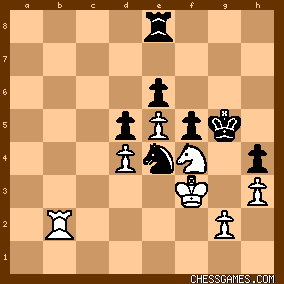
click for larger viewBut instead of this rigorous line, Alapin's 38. Ke3 left: 
click for larger viewThe game then concluded peacefully:
38... Nc4+
39. Kf2 Nd2
40. Ke3 Nc4+
41. Kf2 Nd2
42. Ke3
Drawn.
This draw meant that Blackburne needed to defeat Alapin as White in the replay two days later just to be able to tie for 6th place. Blackgurne had White in the replay, but he was unable to win (in fact he lost) so Blackburne finished out of the money and Alapin ended up where he would have had he won this game, in 5th place. |
|
|
|
|





